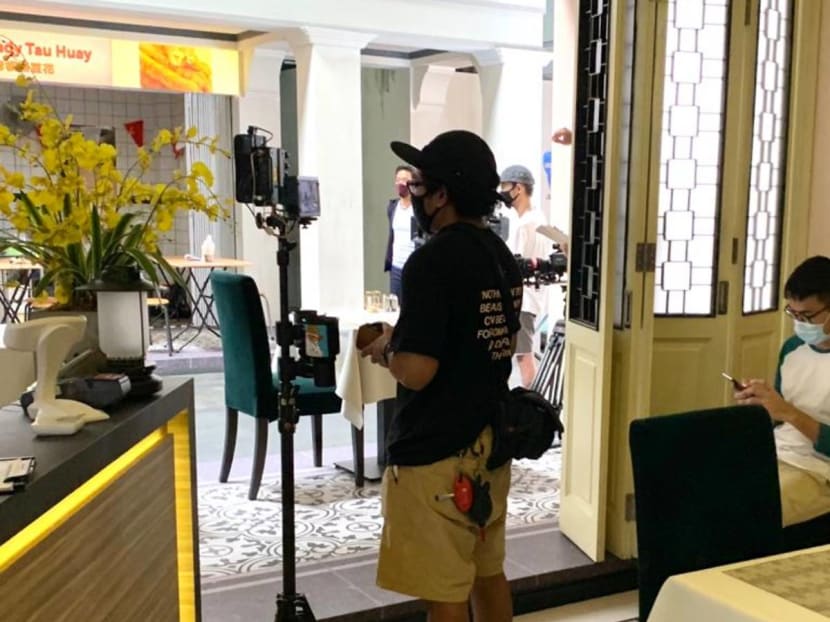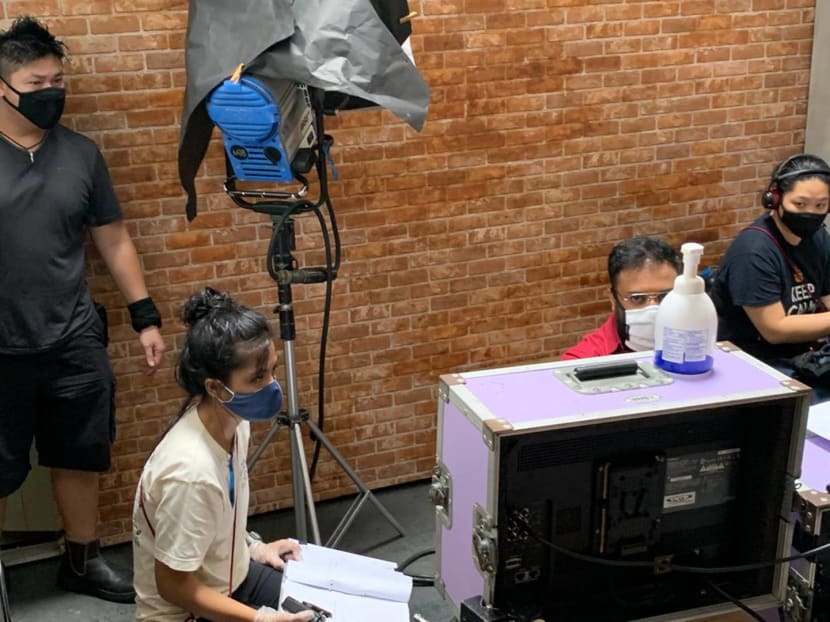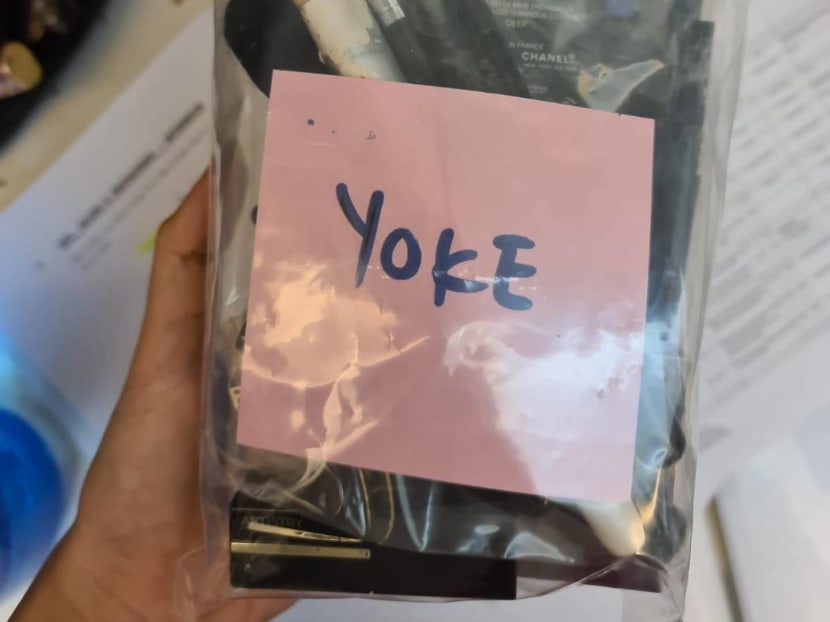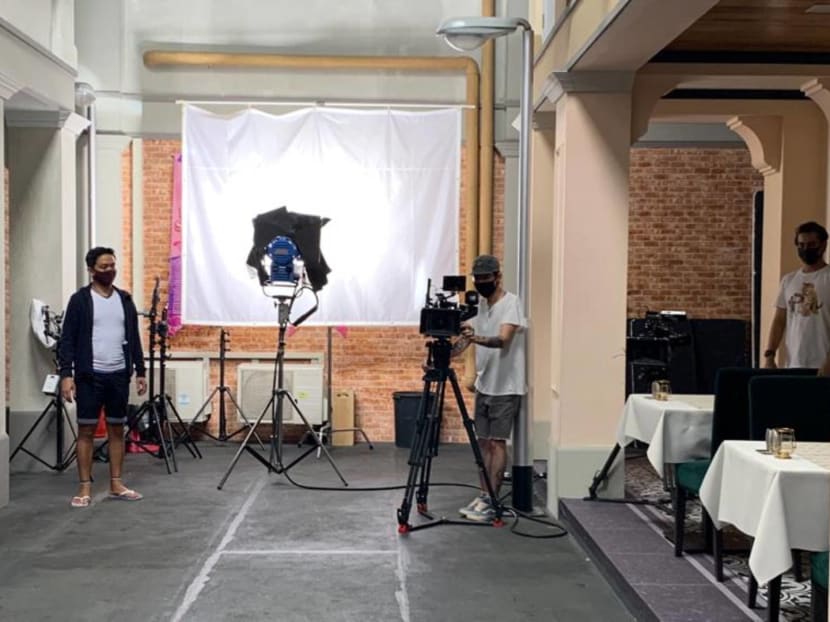No Fighting Or Hugging In Kin: Filming Do’s And Don’ts, Post-Circuit Breaker
At least for now. Producers tell us about the challenges of filming while safe-distancing.
When Rachel Wan returned to work on Tuesday on the long-running Channel 5 soap opera Kin at Infinite Studios, it was like any other day — except she had to constantly remind herself to wear a face mask.
Between scenes, Rachel — who plays Ah Lian-turned-power exec Ah Yoke — and the other actors were given a special mask to wear so that their make-up and hair wouldn't be messed up. “It’s just extra work to remember to put them on and take them off because we were so used to [doing things] without the mask,” Rachel tells 8days.sg
She also had to make alternate plans during breaks. “I missed having lunch with the cast and crew together,” she says. Now we have to segregate.”

Few and far between: Safely-distanced actors rehearsing a scene on the set of 'Kin' at Infinite Studios on June 2, 2020.
Welcome to the new normal.
When the film and TV industry resumed on June 2 after the circuit breaker ended, they, like everybody else, had to do it under a stringent set of rules to manage COVID-19-related risks in the Phase 1 of the government’s reopening strategy.
For the media content producers in Singapore, they have to abide by the ‘Mandatory Safety Rules for the Resumption of Content Production’. Released by the Inforcomm Media Development Authority (IMDA) last Friday (May 29), the rules were put together by IMDA and Singapore Film Commission in consultation with various industry players.
The report contains dozens of protocols, most of them are the same post CB-workplace etiquettes laid out by the Ministry of Manpower — using SafeEntry systems to oversee personnel movement; engaging a health officer to monitor and enforce safety measures; no get-togethers at or outside workplace; the availability of face-masks and sanitisers; the stepping up daily cleaning and disinfecting routines; and telecommuting.

Except in content production, telecommuting isn’t always an option. (Yes, you can make shows over Zoom but how many of those can you do?) Here are some of the safety regulations producers have to adhere to. (For the complete set of rules, click here.)
#1. Ensure clear physical spacing of at least 1m apart.
#2. Stagger working hours and implement tiered arrivals of cast/crew.
#3. Implement or enhance shift or split team arrangements. No interaction between teams/shifts, including off-work.
#4. Maximum production size at any one location is 30 people (including all cast/crew) for Phase 1, with no more than 15 pax on set at any given time.
#5. Video communication on and off-set must be used. Various video conferencing software is available such as Microsoft Teams, Zoom, Skype and Google Hangouts.
#6. Ensure there are no unauthorised and unannounced visitors to the production/office. Only authorised personnel as per call sheet are allowed at the location.
#8. Masks must be worn at all times (except when cast/talent are doing a take/filming).
#9. Face shields must be worn by all personnel who come in proximity with other personnel such as cast/talent (e.g. sound technicians, hair & make-up artists, and costume/wardrobe handlers).

United but apart: The crew of 'Kin' watching a scene being filmed. As per government regulations, hand sanitisers are made available to all personnel.
Needless to say, the on-set restrictions force the creatives to get, well, creative. So if there’s an intimate/fighting/hugging scene, just rewrite it, says Tan Wei-Lyn, executive producer of Kin. “All those scenes that make it hard for us to keep the 2m distance between everyone will be very, very difficult and will involve a lot of cheating with camera angles.” She also has to tweak scripts requiring them to film at F&B outlets, which are still off-limits in Phase 1.
For Ochre Pictures’ Jean Yeo, executive producer of Lion Mums and Last Madame, the 15-person-within-a-zone provision is tougher to work around. “I think drama and film producers will be the hardest hit by this; info-ed shows and documentaries are a little easier,” says Yeo who’s also a member of the committee that consulted on the post CB-guidelines.
On the Last Madame set, for example, Yeo had at least 35-40 people on set; on some sets, she’d need at least 60-100 people especially if there are crowd scenes. “We will have to find innovate and more digital ways of filming, which we had been researching since February.”

Sealed and sterilised: Each day, the actors get their own sterilised make-up kit (this one belongs to Rachel Wan) in this plastic pack; no sharing of make-up is allowed. To minimise contact with the make-up artists, actors are advised to apply their foundation base before coming in. “That means actors have to wake up earlier,” says Rachel. (Photo: Rachel Wan)
There are also concerns of how the restrictions will affect the production pace. “[They] will set production back by at least an hour of shoot per day,” Yeo estimates. “Where we can shoot an average of 6-9 minutes [of screen time] a day — depending on the number of locations — we may now only be able to shoot 4-7 minutes a day. This would mean an extra day of shoot per episode and that will be very hard on our bottom line.
To counter the possible slow-down, Tan tries to make the shoot “a little more straightforward” — less complicated set-ups and shots, simpler scenes with fewer cast members in them, keep the locations simple.” She adds, “We won’t be able to experiment with more daring, time-consuming shots and visuals.”
The limitations are hard on the actors as well, says Tan. “Nothing [in the guidelines] is particularly onerous, but just generally keeping everyone social-distancing affects the camaraderie of the shoot, reduces the interactions between cast, and between cast and crew. It’s a little more isolating and that may affect chemistry.”
She continues, “I think the hardest part is keeping everyone from gravitating towards each other and talking and exchanging a hug or two. [The Kin cast and crew] are a close-knit bunch and they have worked together for a long time. They have to fight that instinct to congregate and interact.”
No matter what, the show must go on even if it’ll take some time to acclimate to the new situation.
If Rachel was used to not wearing masks, then there were folks who got too used to wearing masks. “There were a few times we had to redo scenes after realising some of the socially-distanced extras had forgotten to take off their masks when the cameras started rolling,” Rachel recalls. “And nobody even noticed it.”
Talk about a hard habit to break.
Kin airs Mon-Thur, Ch 5, 8.30pm. It’s also on meWATCH.










